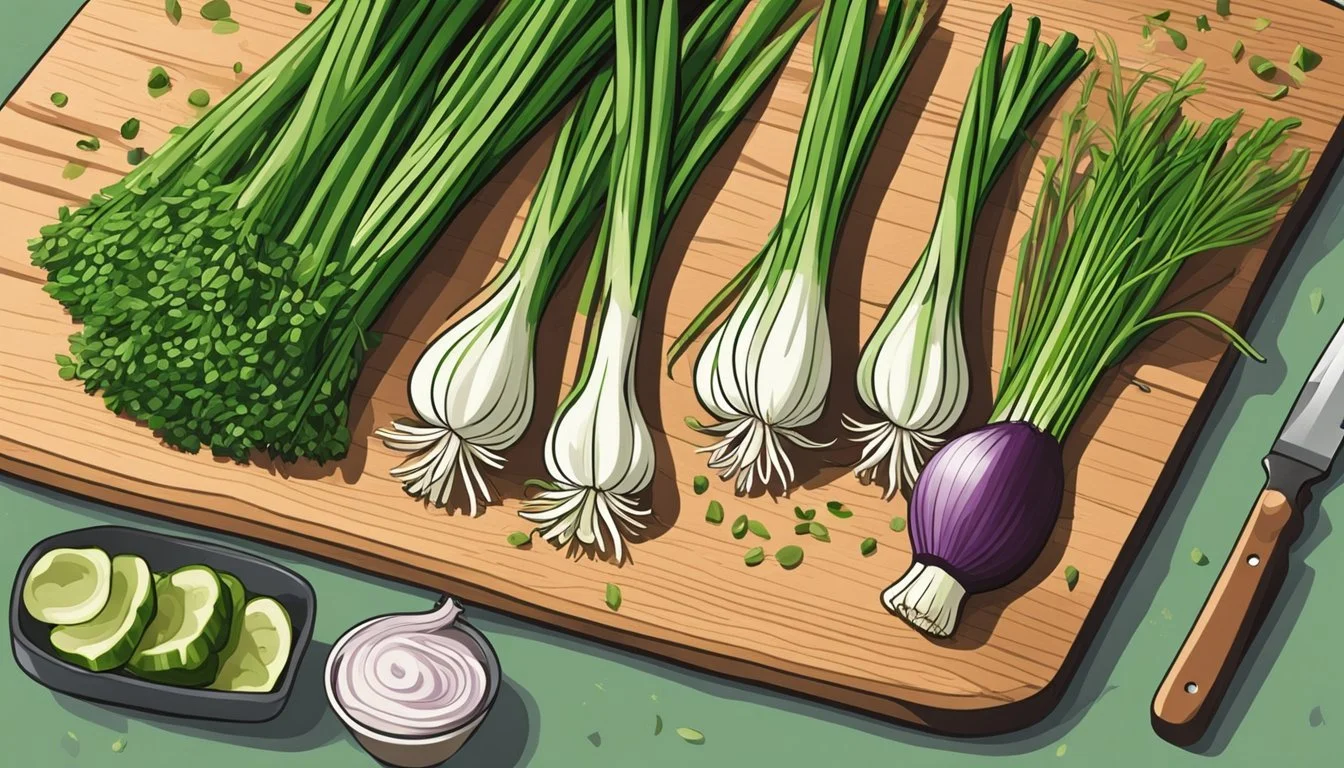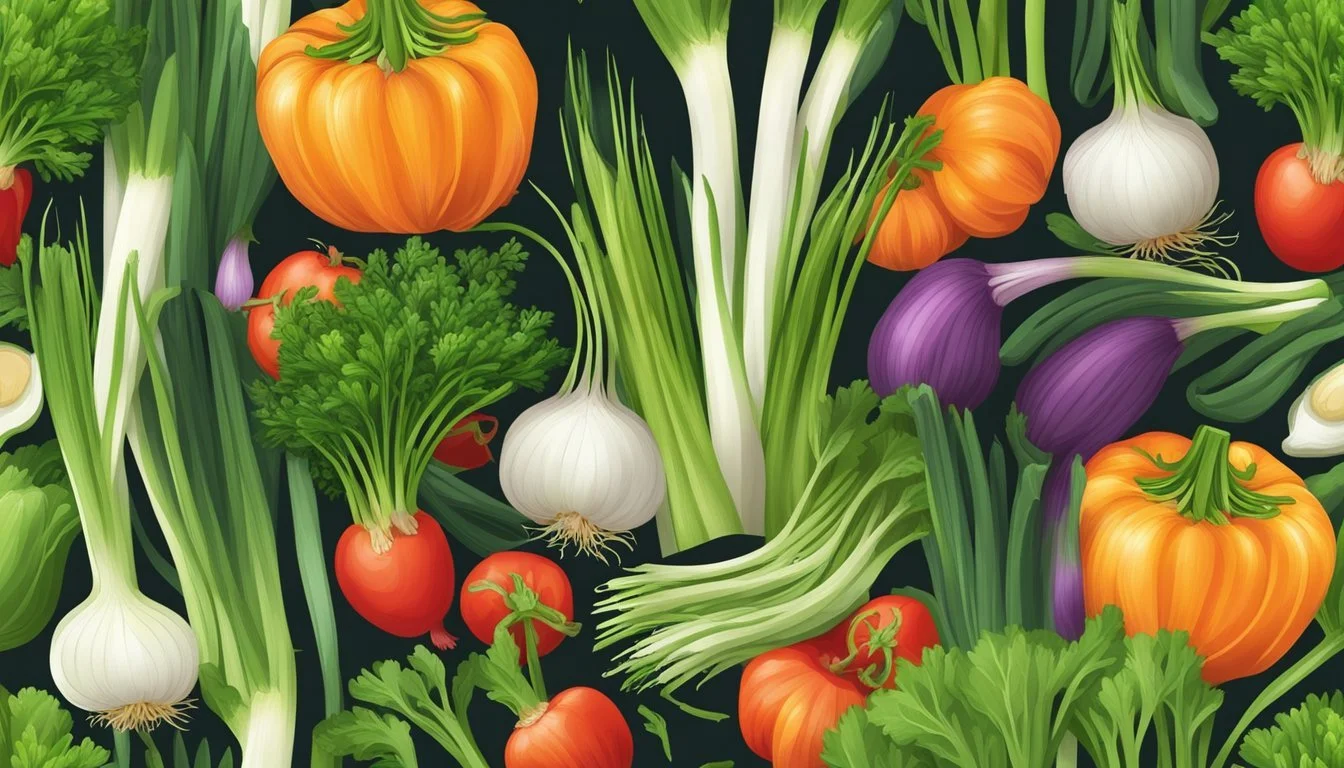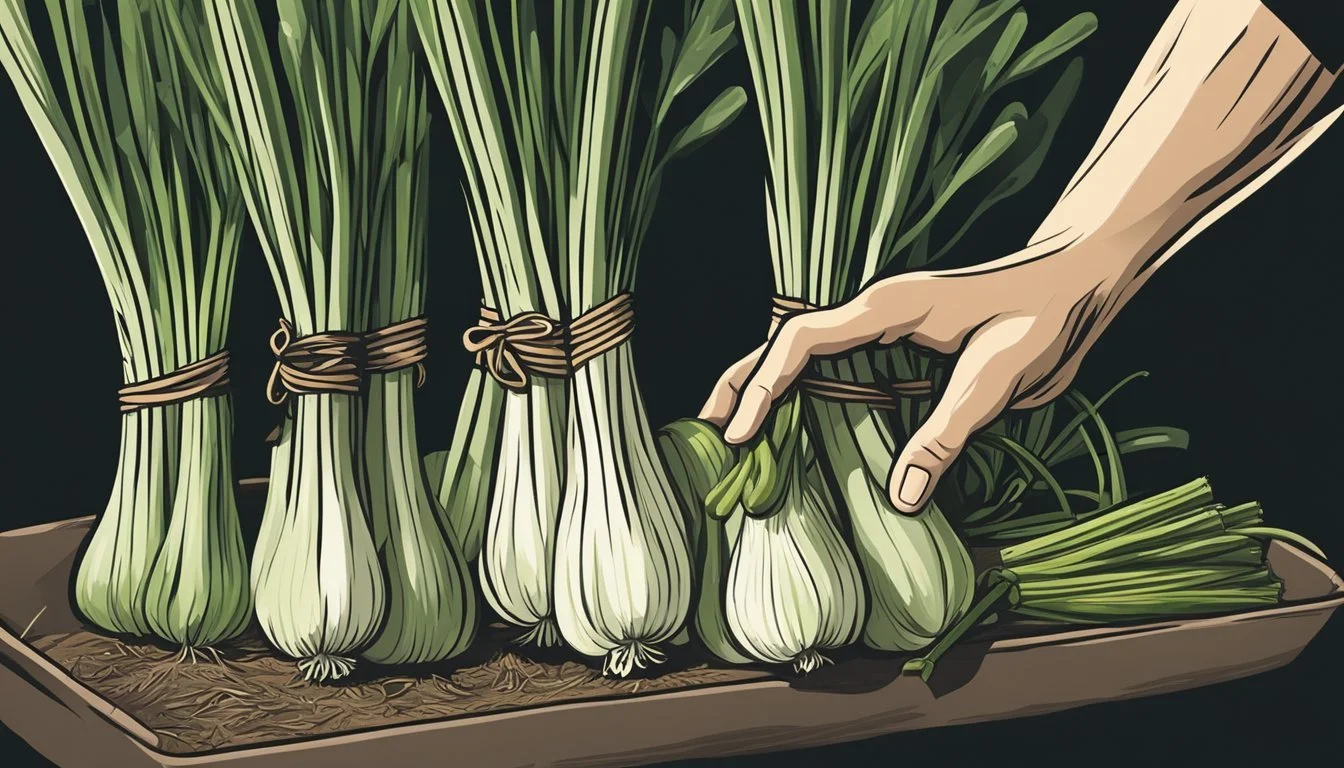Spring Onions Substitutes
Best Alternatives for Your Recipes
Spring onions, known for their delicate flavor and versatile use in various recipes, can sometimes be hard to find or simply run out of stock in your kitchen. When that happens, there are several excellent substitutes that can seamlessly replace spring onions without compromising the taste and quality of your dish. This blog post aims to explore the best alternatives and how they can be used effectively.
One of the most accessible substitutes for spring onions is green onions, also referred to as scallions. They share a similar mild onion flavor and can be used in a variety of dishes ranging from garnishes to integral parts of recipes. Other viable substitutes include leeks and chives, both of which provide a distinct yet compatible flavor profile that can complement most dishes where spring onions are typically used.
For those who enjoy the unique twist in flavor, red onions or wild garlic can serve as suitable alternatives. Red onions, with their sharp yet slightly sweet taste, and wild garlic, with its aromatic and subtle onion flavor, can enhance the flavor of your recipe while maintaining the intended culinary experience. These substitutes ensure that your dish remains deliciously well-rounded without the distinct presence of spring onions.
Understanding Spring Onions
Spring onions, also known as green onions or scallions, are versatile vegetables commonly used in various dishes. These onions are part of the allium family, known for their tender leaves and mild, onion-flavored bulbs.
What Are Spring Onions?
Spring onions are young onions harvested before the bulb fully forms. They feature long green leaves and a small white bulb at the base. Unlike mature onions, their flavor is mild, making them ideal for both raw and cooked applications.
Usage: Commonly chopped or sliced, they add a fresh, crisp texture to salads, soups, and stir-fries. Their mild taste enhances the dish without overpowering it. Spring onions can also be grilled or roasted, bringing out their natural sweetness.
Nutritional Profile: These onions are low in calories and high in nutrients. They contain vitamins A, C, K, and several antioxidants that contribute to overall health.
Appearance: They resemble green onions and scallions but can be distinguished by their development stage, where the bulb has yet to fully mature.
The Allium Family
Spring onions belong to the allium family, which includes garlic, leeks, chives, and regular onions. This family is known for its distinctive flavors and nutritional benefits.
Characteristics: Members of this family typically have a bulb and long green leaves. Many are used for their aromatic properties in cooking, contributing both flavor and nutrition.
Health Benefits: The allium family is rich in compounds like allicin and sulfur, which are believed to have anti-inflammatory and antimicrobial properties. These compounds can help support cardiovascular health and boost the immune system.
Culinary Uses: Each member of the allium family has unique uses. While garlic is often used for its strong flavor, spring onions are chosen for their milder taste. Chives, with their delicate flavor, are often used as a garnish.
By understanding both the characteristics of spring onions and the broader allium family, one can appreciate their role in culinary traditions and their health benefits.
Culinary Uses of Spring Onions
Spring onions are versatile ingredients known for their mild flavor and crisp texture. They enhance various dishes, from salads to Asian cuisine, and serve both as a main ingredient and a garnish.
Flavor Profile
Spring onions provide a delicate, mild onion flavor. Their green tops are slightly sweeter and milder compared to the more pungent white bulbs. This dual profile allows them to be used both raw and cooked. When raw, they add a fresh bite. When cooked, they become softer and blend well with other flavors.
Common Recipes
Spring onions are used in many recipes worldwide. In salads, they add a fresh flavor. In soups and stews, they provide subtle onion notes without overpowering the dish. Asian cuisine often incorporates spring onions in recipes like fried rice and pajeon, a Korean pancake. They are also popular in omelets and as a topping for sandwiches.
Garnishing and Texture
As a garnish, spring onions add both color and texture. Their crispness contrasts well with soft foods, providing a pleasant crunch. They are often sprinkled on soups, stews, and fried rice. In salads, both the green and white parts add a variety of textures and flavors.
Spring onions are also used to garnish more delicate dishes, offering a visual appeal and a subtle flavor lift. The green tops, in particular, are often used in fine strips as an elegant topping.
Nutritional Benefits
Spring onions provide a wide array of nutritional benefits, including essential vitamins and minerals. They play a significant role in promoting overall health and can be a valuable addition to the diet due to their numerous health advantages.
Vitamins and Minerals
Spring onions are rich in Vitamin K, which is essential for blood clotting and bone health. A single serving provides a substantial portion of the daily recommended intake. Additionally, they contain Vitamin C, an antioxidant that supports the immune system and assists in the absorption of iron from plant-based foods.
These onions also offer a good amount of Folate. Folate is vital for DNA synthesis and repair, making it especially important for pregnant women to support fetal development. Spring onions contain smaller amounts of other vitamins and minerals, such as calcium and potassium, which contribute to overall well-being.
Dietary Significance
Spring onions are low in calories, making them an excellent choice for those watching their weight. The high water content in spring onions can help keep the body hydrated, while their dietary fiber aids in digestion and helps maintain gastrointestinal health.
The combination of antioxidants and anti-inflammatory compounds found in spring onions may help reduce the risk of chronic diseases. In particular, they are recognized for their potential benefits in cardiovascular health due to their ability to lower blood cholesterol levels and improve heart function. Including spring onions in meals can enhance health and provide necessary nutrients without adding excessive calories.
Best Substitutes for Spring Onions
Spring onions can be substituted with a variety of other vegetables that share similar textures and flavors. Shallots, leeks, and chives are among the top choices for achieving similar results in dishes.
Shallots
Shallots are a close substitute for spring onions due to their mild flavor and crunchy texture. They belong to the allium family, like onions and garlic, and can be used in both raw and cooked forms.
One key point about shallots is their versatile flavor profile. They offer a subtle onion taste without being overpowering. This makes them suitable for recipes where the onion flavor needs to be more delicate.
Though shallots lack the green stalks of spring onions, their flavor intensity can bridge the gap in most dishes. They blend particularly well in salads, dressings, and lightly sautéed dishes.
Leeks
Leeks serve as an excellent substitute for spring onions, mainly due to their layered structure and mild taste. They are larger than spring onions and have a more fibrous texture.
Leeks are ideal for soups, stews, and casseroles. Their white base can be used similarly to the bulb of a spring onion, while the green tops can stand in for the green parts of spring onions.
When using leeks, it is crucial to clean them thoroughly. Dirt often hides between their layers. Their mild onion-like flavor complements various dishes without dominating the other ingredients.
Chives
Chives are another good replacement for spring onions, known for their slender green stems and mild flavor. As a part of the allium family, they offer a subtle oniony taste.
Chives are best used raw or added at the end of cooking. This preserves their delicate flavor and texture. They work well in garnishes, salads, soups, and omelets.
While chives do not have a bulb, their green stalks can replicate the appearance and taste of spring onion tops. Moreover, the mild flavor of chives ensures they enhance rather than overpower the dish.
Additional Substitutes and Varieties
When looking for spring onion substitutes, other onion varieties and herbs blend well into different recipes and dishes. Exploring these options can ensure the recipe retains its flavor and texture.
Alternative Onion Varieties
Several onion varieties can replace spring onions due to similarities in flavor and texture. Red onions add a slightly sweet and mild flavor, offering a vibrant color to dishes. They work well in salads and raw preparations.
White onions have a crisper texture and are potent, making them a good option for cooked dishes where a strong flavor is desired. They can be used both raw and cooked but are often preferred cooked to mellow their sharpness.
Yellow onions are versatile and the most commonly used. They balance sweet and tangy flavors, making them ideal for soups, stews, and various cooked preparations.
Leeks can substitute spring onions, especially their green parts, which provide delicate onion flavors. Finely chopped, they can be used both raw in garnish and cooked in main dishes.
Herbs and Aromatics
Chives are a great substitute for the green part of spring onions. They offer a mild, onion-like flavor and are perfect as a fresh garnish. Chives can be snipped directly onto dishes for a light, subtle onion taste without overpowering the main dish.
Garlic provides a more intense flavor but can add depth to dishes needing a hint of pungency. It's best used in cooked dishes where its strong flavor can blend well.
Ginger is another aromatic that, though different in taste, can add a fresh, spicy element to dishes. It works best in stir-fries and Asian recipes, where its zest complements other ingredients.
Onion powder and dehydrated onions serve as convenient stand-ins when fresh spring onions aren't available. They provide concentrated flavor and are suitable for soups, stews, and marinades. Just ensure to use them in appropriate proportions to avoid overpowering the dish.
These alternatives ensure you can always find a fitting substitute for spring onions to enhance your culinary creations.
Selecting and Storing Substitutes
Choosing the best spring onion substitute and storing it properly can ensure your dishes maintain their desired flavor and freshness. Each substitute has its own characteristics and storage needs.
Choosing the Right Substitute
Selecting the right substitute depends on the flavor profile and texture desired. Chives are the top choice as they belong to the allium family and offer a mild onion flavor, making them ideal for garnishing. Scallions are highly similar to spring onions, offering a similar texture and taste. Shallots provide a delicate, sweet flavor, perfect for cooked dishes, but might be overpowering raw. Leeks are another alternative, especially when finely chopped; their mild flavor makes them versatile.
A summary of substitutes:
Chives: Mild, best for garnishing.
Scallions: Similar to spring onions.
Shallots: Sweet, delicate, best cooked.
Leeks: Mild, versatile.
Storage Tips for Freshness
Proper storage is crucial to maintain the freshness of these delicate substitutes. For chives and scallions, store them in the refrigerator, wrapped in a damp paper towel and placed in a plastic bag. This method helps retain moisture and prolong freshness. Shallots should be stored in a cool, dark place to prevent sprouting and softening. Keep leeks refrigerated, either wrapped or placed in a perforated plastic bag to allow air circulation while maintaining humidity.
Freshness tips:
Chives & Scallions: Damp paper towel + plastic bag in the fridge.
Shallots: Cool, dark place.
Leeks: Perforated plastic bag in the fridge.
By following these guidelines, you ensure that your selected substitutes remain as fresh and flavorful as possible for your culinary needs.
Growing and Harvesting Alternatives
Growing alternatives to spring onions is beneficial, offering flexibility in flavor and harvest time. Wild alternatives like wild garlic can be foraged, adding diversity to your culinary options.
Home Gardening Tips
For those interested in home gardening, chives and shallots are excellent spring onion substitutes. Chives thrive in well-drained soil and require moderate sunlight. Place them about 8-10 inches apart to ensure healthy growth. Shallots prefer rich, loamy soil and can be harvested in around 90 days. Plant shallots in late fall or early spring, keeping the bulbs just below the soil surface.
Leeks, known for their mild, sweet flavor, also make a good substitute. They require about 120-150 days to mature. Plant seeds 1/2 inch deep and space them 6 inches apart. Regular watering and soil that's high in organic matter are crucial for leek cultivation.
Wild Alternatives and Foraging
Foraging for wild alternatives can be rewarding. Wild garlic and ramps (wild leeks) are excellent finds. Wild garlic commonly grows in woodlands and has a distinct, garlic-like aroma. It can be collected in spring or fall. Always ensure proper identification before harvesting to avoid toxic look-alikes.
Ramps grow in shady, moist forests and are identifiable by their broad, green leaves and red stems. Harvest their edible leaves and bulbs in early spring before they flower. Sustainable harvesting is important—only take a small portion of any wild patch to allow for regrowth.
Using wild and home-grown substitutes can enrich your cooking while providing varied flavors and textures.





